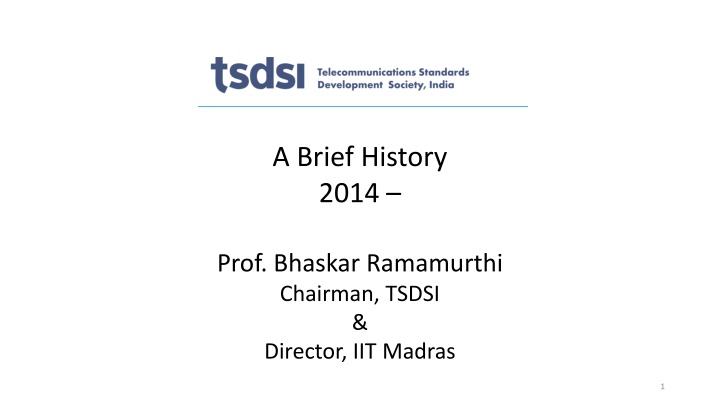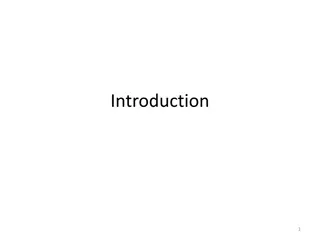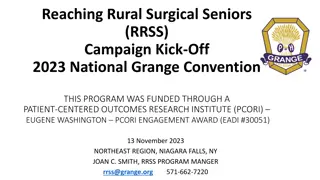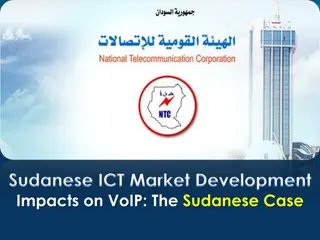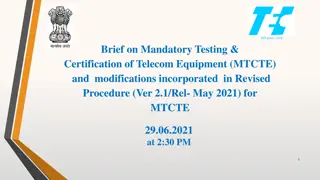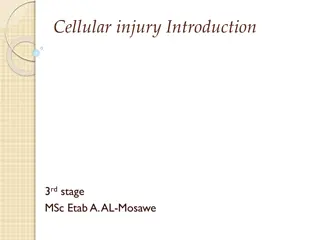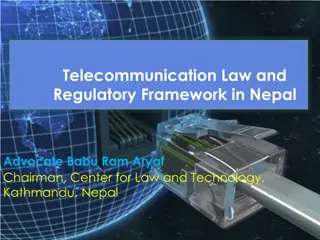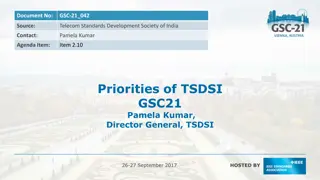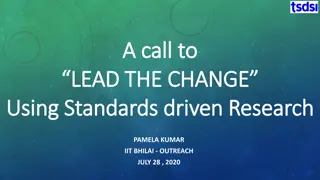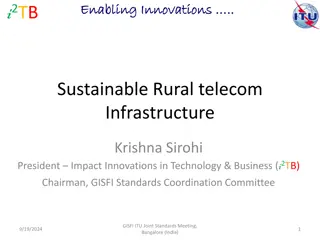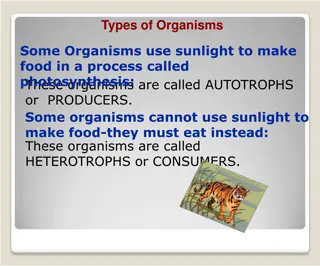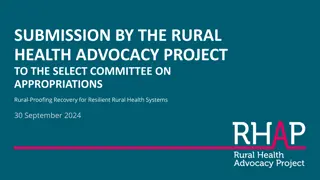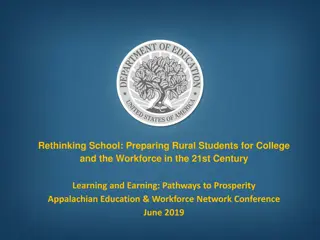Addressing Telecom Standards Challenges: A Case Study of TSDSI and Rural Cellular Coverage
Understanding the complexities of telecom standards worldwide, the Telecom Standards Development Society, India (TSDSI), was established to cater to India's unique requirements and provide affordable solutions. With a focus on rural cellular coverage challenges, the need for large cell areas for slow-moving users emerged, highlighting the importance of custom solutions. The case study illustrates the limitations of global standards in serving diverse populations, emphasizing the necessity of member-driven Standards Bodies for effective consensus building and innovation.
Download Presentation

Please find below an Image/Link to download the presentation.
The content on the website is provided AS IS for your information and personal use only. It may not be sold, licensed, or shared on other websites without obtaining consent from the author.If you encounter any issues during the download, it is possible that the publisher has removed the file from their server.
You are allowed to download the files provided on this website for personal or commercial use, subject to the condition that they are used lawfully. All files are the property of their respective owners.
The content on the website is provided AS IS for your information and personal use only. It may not be sold, licensed, or shared on other websites without obtaining consent from the author.
E N D
Presentation Transcript
A Brief History 2014 Prof. Bhaskar Ramamurthi Chairman, TSDSI & Director, IIT Madras 1
Need for TSDSI Telecom standards are complex and innovations are driven by industry and startups Major geographies/economies have multi-stakeholder Telecom Standards bodies that do all the detailed technical work and consensus building ETSI (Europe), ATIS (USA), CCSA (China), TTA (Korea), ARIB&TTC (Japan), These bodies can ensure that national/regional requirements are addressed and suitabkle solutions included in global standards TSDSI formed to address India s requirements and provide affordable, customised solutions Now looking to also address similar needs of other developing economies
Case study: Rural Cellular coverage After 2G and 3G cellular systems were deployed in India in 1997- 2007, we realised that rural coverage for the standard means reaching phones in fast-moving cars on highways and trains Whereas, in India, 800M people live in 0.6M habitations dispersed across 3M sq km Walk in any direction from anywhere within 2 km you will reach a village with 1300 people on average One tower had to serve villages upto 10 km away Systems built to global standards were unable to provide voice, leave alone data, services to most villages Their ability to serve people in cars moving at 160 kmph very difficult to achieve no relevance to us
Low Mobility Large Cell (LMLC) What India (and many other developing countries) need(s) is large coverage area but for nomadic or slow-moving users This trade-off not exercised by global standards India tried taking this to ITU WP5D in 2008-9 We even developed a rural channel model for this, and several countries carried out studies But ITU told us to initiate a study item and adhere to the well-defined process for initiating and carrying out to completion such activities We felt the serious handicap of not having a member-driven Standards Body in India which could systematically carry out the studies, attend global meetings, drive consensus, etc
Indian Scripts SMS a missed opportunity In 2G systems, SMS was a major enabler of many services adding great value in developing economies It was conceived as an afterthought for developed economies as a replacement for pagers 140 7-bit characters in Roman script, or ~60 16-bit characters for arbitrary scripts Roman script good for many countries 60 characters good for logographic scripts too, not so for Indian scripts CEWiT@IIT Madras even got 140x7-bit codes included for all official Indian scripts in 2G standard But it was never realised in systems because of lack of a member-driven participatory standards body
TSDSI formed in 2013 In response to this felt need, TSDSI was formed as a member-driven autonomous organization with government support Similar to standards bodies in other geographies Rule-based consensus-building platform for technical work towards new standards Members from service providers, industry, academia, research institutions, startups, government TSDSI is a partner/member in many global standards-making forums ITU, 3GPP, oneM2M, GSC,
Impact...in 5 years - LMLC LMLC introduced in ITU as a mandatory requirement for IMT 2020 global standards (5G) Watered-down 3 km coverage target, due to pressures from developed economies Members of TSDSI participating in 3GPP introduced new features in upcoming 5G standard to satisfy LMLC requirements better Some features left out during consensus building TSDSI submitting Indian variant of 5G to ITU with 6-km LMLC coverage Fully inter-operable with 3GPP standard Can be implemented as a software variant
Impact in 5 years - NAVIC India launched its own regional navigation system NAVIC Superior alternative to GPS 3GPP wireless standards will now have support for NAVIC in addition to GPS, Glosnass, BeiDou Handsets manufactured in India (95% last year) can have support for NAVIC also Story with a good ending unlike the Indian-scripts SMS story
Impact in 5 years - IoT India building 100 smart cities and more.. Vendor-driven IoT platforms threatening to proliferate Will lock cities into proprietary platforms with no exit or flexibility (think MS Windows ) Important for developing countries to implement open multi-vendor platforms New technologies with evolving pathways to mass adoption Also important to ensure affordability Ability to exercise tradeoffs on some KPIs Partnering in oneM2M to ensure a future-proof glidepath Also open up early opportunities for Indian companies
Key aspect in growth of TSDSI Study groups that define new work items and drive technical work throughout the year Volunteers from all verticals industry, service providers, academia, startups, - need to pitch in Participation in global forums The difficult part, due to time and financial costs Numbers matter in these forums, apart from technical strength Roadmap for steady expansion of activities consistent with available resources Working in tandem with government
In future expand scope to address needs of hitherto unrepresented regions/economies 3GPP has already requested TSDSI to do this enter into MOUs with sister organizations in these countries consider a form of membership for sister organizations or their members co-ordinate with these countries at ITU to ensure their voices are heard
